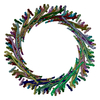+ Open data
Open data
- Basic information
Basic information
| Entry | Database: PDB / ID: 8aky | ||||||
|---|---|---|---|---|---|---|---|
| Title | 290 A SynPspA rod after incubation with ATP | ||||||
 Components Components | Chloroplast membrane-associated 30 kD protein | ||||||
 Keywords Keywords | LIPID BINDING PROTEIN / Nucleotide binding / Helical assembly / ESCRT-III fold / Membrane remodeling | ||||||
| Function / homology | PspA/IM30 / PspA/IM30 family / Chloroplast membrane-associated 30 kD protein Function and homology information Function and homology information | ||||||
| Biological species |  | ||||||
| Method | ELECTRON MICROSCOPY / helical reconstruction / cryo EM / Resolution: 4.7 Å | ||||||
 Authors Authors | Junglas, B. / Hudina, E. / Schoennenbeck, P. / Ritter, I. / Santiago-Schuebel, B. / Huesgen, P. / Sachse, C. | ||||||
| Funding support | European Union, 1items
| ||||||
 Citation Citation |  Journal: Nat Struct Mol Biol / Year: 2025 Journal: Nat Struct Mol Biol / Year: 2025Title: Structural plasticity of bacterial ESCRT-III protein PspA in higher-order assemblies. Authors: Benedikt Junglas / Esther Hudina / Philipp Schönnenbeck / Ilona Ritter / Anja Heddier / Beatrix Santiago-Schübel / Pitter F Huesgen / Dirk Schneider / Carsten Sachse /  Abstract: Eukaryotic members of the endosome sorting complex required for transport-III (ESCRT-III) family have been shown to form diverse higher-order assemblies. The bacterial phage shock protein A (PspA) ...Eukaryotic members of the endosome sorting complex required for transport-III (ESCRT-III) family have been shown to form diverse higher-order assemblies. The bacterial phage shock protein A (PspA) has been identified as a member of the ESCRT-III superfamily, and PspA homo-oligomerizes to form rod-shaped assemblies. As observed for eukaryotic ESCRT-III, PspA forms tubular assemblies of varying diameters. Using electron cryo-electron microscopy, we determined 61 Synechocystis PspA structures and observed in molecular detail how the structural plasticity of PspA rods is mediated by conformational changes at three hinge regions in the monomer and by the fixed and changing molecular contacts between protomers. Moreover, we reduced and increased the structural plasticity of PspA rods by removing the loop connecting helices α3/α4 and the addition of nucleotides, respectively. Based on our analysis of PspA-mediated membrane remodeling, we suggest that the observed mode of structural plasticity is a prerequisite for the biological function of ESCRT-III members. | ||||||
| History |
|
- Structure visualization
Structure visualization
| Structure viewer | Molecule:  Molmil Molmil Jmol/JSmol Jmol/JSmol |
|---|
- Downloads & links
Downloads & links
- Download
Download
| PDBx/mmCIF format |  8aky.cif.gz 8aky.cif.gz | 3.7 MB | Display |  PDBx/mmCIF format PDBx/mmCIF format |
|---|---|---|---|---|
| PDB format |  pdb8aky.ent.gz pdb8aky.ent.gz | Display |  PDB format PDB format | |
| PDBx/mmJSON format |  8aky.json.gz 8aky.json.gz | Tree view |  PDBx/mmJSON format PDBx/mmJSON format | |
| Others |  Other downloads Other downloads |
-Validation report
| Summary document |  8aky_validation.pdf.gz 8aky_validation.pdf.gz | 1.8 MB | Display |  wwPDB validaton report wwPDB validaton report |
|---|---|---|---|---|
| Full document |  8aky_full_validation.pdf.gz 8aky_full_validation.pdf.gz | 1.8 MB | Display | |
| Data in XML |  8aky_validation.xml.gz 8aky_validation.xml.gz | 253.8 KB | Display | |
| Data in CIF |  8aky_validation.cif.gz 8aky_validation.cif.gz | 349.1 KB | Display | |
| Arichive directory |  https://data.pdbj.org/pub/pdb/validation_reports/ak/8aky https://data.pdbj.org/pub/pdb/validation_reports/ak/8aky ftp://data.pdbj.org/pub/pdb/validation_reports/ak/8aky ftp://data.pdbj.org/pub/pdb/validation_reports/ak/8aky | HTTPS FTP |
-Related structure data
| Related structure data |  15497MC  8akqC  8akrC  8aksC  8aktC  8akuC  8akvC  8akwC  8akxC  8akzC  8al0C M: map data used to model this data C: citing same article ( |
|---|---|
| Similar structure data | Similarity search - Function & homology  F&H Search F&H Search |
- Links
Links
- Assembly
Assembly
| Deposited unit | 
|
|---|---|
| 1 |
|
- Components
Components
| #1: Protein | Mass: 28097.758 Da / Num. of mol.: 60 Source method: isolated from a genetically manipulated source Source: (gene. exp.)  Details (production host): Based on pET50b(+) with deletion of NusA tag Production host:  |
|---|
-Experimental details
-Experiment
| Experiment | Method: ELECTRON MICROSCOPY |
|---|---|
| EM experiment | Aggregation state: HELICAL ARRAY / 3D reconstruction method: helical reconstruction |
- Sample preparation
Sample preparation
| Component | Name: Phage shock protein A (PspA) / Type: COMPLEX / Entity ID: all / Source: RECOMBINANT |
|---|---|
| Molecular weight | Value: 149.2 kDa/nm / Experimental value: NO |
| Source (natural) | Organism:  |
| Source (recombinant) | Organism:  |
| Buffer solution | pH: 8 |
| Specimen | Embedding applied: NO / Shadowing applied: NO / Staining applied: NO / Vitrification applied: YES |
| Vitrification | Cryogen name: ETHANE |
- Electron microscopy imaging
Electron microscopy imaging
| Experimental equipment |  Model: Talos Arctica / Image courtesy: FEI Company |
|---|---|
| Microscopy | Model: FEI TALOS ARCTICA |
| Electron gun | Electron source:  FIELD EMISSION GUN / Accelerating voltage: 200 kV / Illumination mode: FLOOD BEAM FIELD EMISSION GUN / Accelerating voltage: 200 kV / Illumination mode: FLOOD BEAM |
| Electron lens | Mode: BRIGHT FIELD / Nominal defocus max: 4000 nm / Nominal defocus min: 1000 nm |
| Image recording | Electron dose: 58 e/Å2 / Film or detector model: GATAN K3 BIOQUANTUM (6k x 4k) |
- Processing
Processing
| Software | Name: UCSF ChimeraX / Version: 1.3/v9 / Classification: model building / URL: https://www.rbvi.ucsf.edu/chimerax/ / Os: macOS / Type: package |
|---|---|
| CTF correction | Type: PHASE FLIPPING AND AMPLITUDE CORRECTION |
| Helical symmerty | Angular rotation/subunit: 21.2 ° / Axial rise/subunit: 6.92 Å / Axial symmetry: C4 |
| 3D reconstruction | Resolution: 4.7 Å / Resolution method: FSC 0.143 CUT-OFF / Num. of particles: 44377 / Symmetry type: HELICAL |
 Movie
Movie Controller
Controller













 PDBj
PDBj